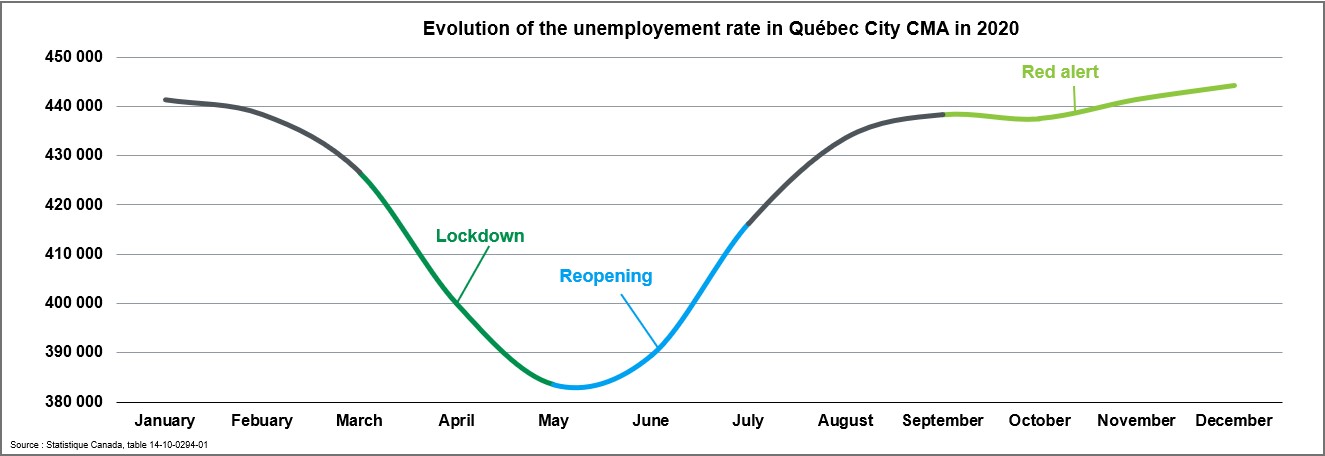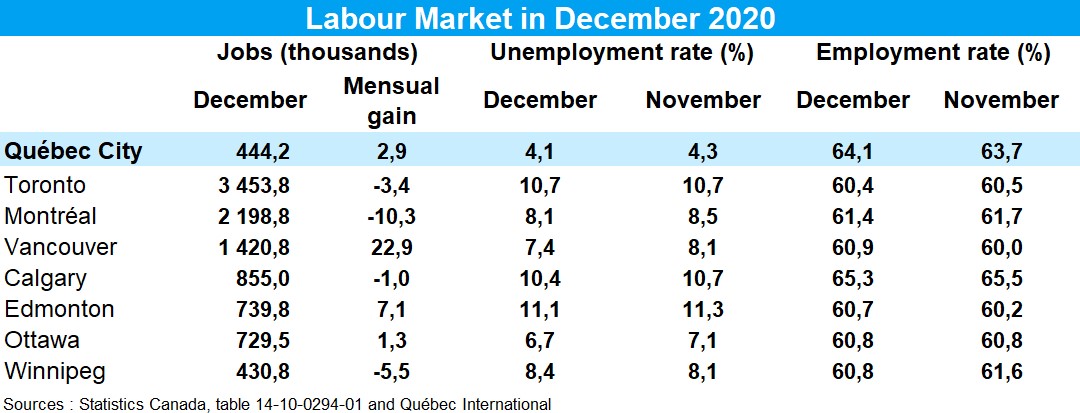Highlights
- Employment increased by 2,900 jobs (+0.7%) in December in the Québec City census metropolitan area (CMA). This is the second consecutive month that the employment level is higher than in February 2020, before the crisis.
- The unemployment rate continues to fall after peaking at the end of the first wave. It declined from 11.9% in June to 4.1% in December 2020, a return to the level recorded before the pandemic.
- Both the labour force participation and employment rates increased from November 2020 to 66.9% and 64.1%, respectively, in December. Despite this monthly increase, both the labour force participation and employment rates are lower than at the same time last year.
- In the province of Quebec, comparable data shows a decline in employment of 4,600 jobs (-0.1%) in December. The unemployment rate decreased from 7.4% in November to 7.2% in December.
Charts


Commentary
Data from Statistics Canada’s Labour Force Survey (LFS) reflects labour market conditions during the week of December 6 to 12 as the area prepared for the holiday season in the context of COVID-19. At that time, the Québec City census metropolitan area (CMA) was at the “red zone” maximum alert level for a third consecutive month. The next LFS results will reflect other public health measures adopted at the end of December.
Employment
Statistics Canada data shows that the number of employed people in the area was 444,200 in December 2020, an increase of 2,900 jobs (+0.7%) from November. This is a clearer result than those observed in the province of Quebec (-0.1%) and Canada (+0.1%). In December, in the Québec City CMA, there were more jobs than in February 2020, before the crisis began, for a second month in a row. Nevertheless, the estimated employment level in December 2020 lags 3,700 jobs (-0.8%) behind the level observed in the same period in 2019.
Unemployment is Reducing
Statistics Canada reports that the area’s labour market tightened slightly in December. The unemployment rate fell from 4.3% in November to 4.1% in December. A sixth consecutive monthly decline keeps Québec City at the top of the Canadian CMAs with the lowest unemployment rate. Thus, in December, the unemployment rate returned to the level recorded before the pandemic (February 2020).
Between November and December 2020, the number of unemployed decreased from 19,800 to 19,100, bringing the number of unemployed people to a level similar to that before the economic downturn, namely 18,700 unemployed (February 2020).
Labour Market Participation
In December, both labour force participation and employment rates peaked at 66.9% and 64.1%, respectively, for the year 2020. However, labour market participation is lower than at the same time last year. In this regard, December 2019 had labour force participation and employment rates of 67.4% and 65%. The number of people active in the labour market increased by 2,200 individuals (+0.5%) between November and December. Thus, the active population reached 463,300 individuals, representing 6,300 more than in February.
Note that the December 2020 data for the Québec City CMA is a limited assessment of labour market conditions. The coming months will tell us more about the resilience of employment in the face of the latest measures adopted by the Quebec government. It should be remembered that last spring, the area was the Canadian champion in this regard.
Note to readers
The available data for the Québec City census metropolitan area (CMA) was given special treatment (three-month moving average) due to the small sample size, which has the effect of mitigating the strong fluctuations in the data. Circumstances in recent months have generated extreme variations that cannot be fully observed with this data. In addition, the data provides information on the trend over the past three months. Thus, data collected in October and November affects the estimations published for December. Please also note that we use comparable data for the province of Quebec and the other CMAs in this document. To learn more, please visit: these reminders about moving averages (ISQ, in French only).
December data from the Labour Force Survey (LFS) was collected from respondents for the reference week of December 6 to 12. Thus, the “red zone” alert effective in some regions of the province is reflected in the data. For more details, please see the Government of Quebec’s map of COVID-19 alert levels by region.
Statistics Canada's definition of “unemployment” is based on the activity of job search and the availability to take a job. Therefore, the definition of unemployed people is those who, during the reference week of December 6 to 12, were available for work and:
- were without work, but had looked for work in the past four weeks;
- were on temporary layoff with an expectation of recall; or
- were without work, but had a job to start within four weeks from the reference week.
To learn more, please visit: https://www150.statcan.gc.ca/n1/en/catalogue/71-543-G.
Émile Émond
Economist
Québec International



